This past weekend, a group of us international students traveled to Bahurutshe Cultural lodge for an overnight village-like stay. We arrived around 9am for breakfast and were greeted by several older women wearing long skirts and long-sleeved shirts; several of them were barefoot. They did a brief welcoming dance and encouraged us to join in, which was fun enough, but felt a bit uncomfortably touristy. 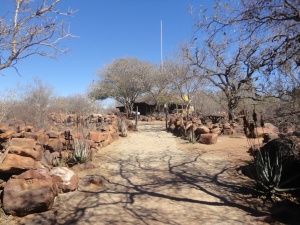 Before we lined up to wash our hands and get breakfast, one the woman instructed us that it was part of their culture that the men were expected to eat first. This was an experience unique to the villages and rural culture, since while I did notice more men than women cutting lines in Gabs (line-cutting is not uncommon), there was no set rule. As a traveling westerner, I definitely want to respect other cultures and I try to be aware of my own presumptions, but this still rubbed me the wrong way. The “men first” rule when it comes to food is problematic in my eyes: a remnant from old patriarchal practices. In a number of traditionally patriarchal cultures, including those in Europe, historically, there have been issues of women becoming severely malnourished because the men were valued more and were entitled to the best food first. When there wasn’t enough, the women were expected to settle for less or go without. For us, it wasn’t a big deal because obviously Bahurutshe Cultural lodge would provide more than enough food for its tourists.
Before we lined up to wash our hands and get breakfast, one the woman instructed us that it was part of their culture that the men were expected to eat first. This was an experience unique to the villages and rural culture, since while I did notice more men than women cutting lines in Gabs (line-cutting is not uncommon), there was no set rule. As a traveling westerner, I definitely want to respect other cultures and I try to be aware of my own presumptions, but this still rubbed me the wrong way. The “men first” rule when it comes to food is problematic in my eyes: a remnant from old patriarchal practices. In a number of traditionally patriarchal cultures, including those in Europe, historically, there have been issues of women becoming severely malnourished because the men were valued more and were entitled to the best food first. When there wasn’t enough, the women were expected to settle for less or go without. For us, it wasn’t a big deal because obviously Bahurutshe Cultural lodge would provide more than enough food for its tourists.
After a breakfast of eggs, beans, ground beef with vegetables, fat cakes, tea, and super-sweet orange juice, we took the bus further out into the bush and “hiked” (more like walked) several kilometers to a gorge.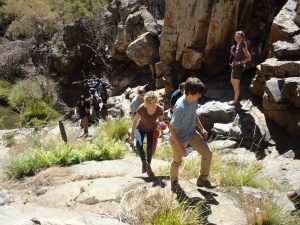 Our tour guide told us we couldn’t take photographs unless someone was in them because the gorge was sacred land. I didn’t understand why they allowed photos at all then if the land was sacred, but I assumed it was some sort of odd compromise. We climbed up one part of the gorge that I think is a full-on waterfall during the rainy season. The rocks were a bit slippery, but nothing we couldn’t handle. Our tour guide was pretty nervous about us all climbing safely, though.
Our tour guide told us we couldn’t take photographs unless someone was in them because the gorge was sacred land. I didn’t understand why they allowed photos at all then if the land was sacred, but I assumed it was some sort of odd compromise. We climbed up one part of the gorge that I think is a full-on waterfall during the rainy season. The rocks were a bit slippery, but nothing we couldn’t handle. Our tour guide was pretty nervous about us all climbing safely, though.
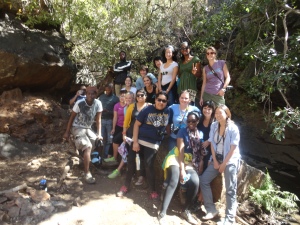 The short trek was followed by a bush braai and then a cultural performance around the fire back at the Bahurutshe lodge. Everyone has a tribe and totem in Botswana. As one the women was telling us: “When you say ‘crocodile,’ we know where you come from.” Their totem is the baboon. I had mixed feelings about the performance. While I thought it was awesome and entertaining, I wondered if I should have been seeing it at all. It felt like…touristic voyeurism. How often did they perform these dances? Did they still perform them for themselves or was it primarily (or only) for tourists? How did the dancers feel about it? How did they feel about us taking photos? Was it just a job to them? At one point, I noticed one the dancers open her buffalo-skin pouch to check her phone, which was so refreshing. It was something small that broke the ‘traditional’ spell.
The short trek was followed by a bush braai and then a cultural performance around the fire back at the Bahurutshe lodge. Everyone has a tribe and totem in Botswana. As one the women was telling us: “When you say ‘crocodile,’ we know where you come from.” Their totem is the baboon. I had mixed feelings about the performance. While I thought it was awesome and entertaining, I wondered if I should have been seeing it at all. It felt like…touristic voyeurism. How often did they perform these dances? Did they still perform them for themselves or was it primarily (or only) for tourists? How did the dancers feel about it? How did they feel about us taking photos? Was it just a job to them? At one point, I noticed one the dancers open her buffalo-skin pouch to check her phone, which was so refreshing. It was something small that broke the ‘traditional’ spell.
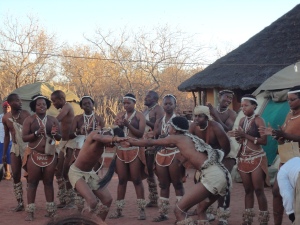
Despite my qualms, many of the dancers looked like they were having a good time and they occasionally laughed amongst themselves and chatted in Setswana. The primary male dancers were absorbed into the performance, going all out with gestures and facial expressions. One of the best performances was a courting dance. As they danced, two older women went around the fire with buckets, throwing water on the sand where the performers stepped. I was excited, because the footwork used in most of the dances was the same as I had learned the previous week in the traditional dance club at the University of Botswana. It was great seeing what the dances were supposed to look like when the dancers were well-practiced, coordinated, and dressed in the traditional garb, which was largely made from animal skins.
After the dances, the older women demonstrated traditional chores/work allocated to girls such as pounding sorghum and grinding it on a rock. The woman who had greeted us earlier that day did all the speaking, (it was clear that she was in charge), and even brought her granddaughter up for some good-natured public embarrassment. Her granddaughter was very modern and was wearing jeans, a T-shirt, flats, and some jewelry. She wasn’t as familiar with the chores as the older women and they laughed benignly at her as her grandmother pretended to scold her. Then the woman invited girls from the audience to come up and try while she sent the few boys to a table to play chess!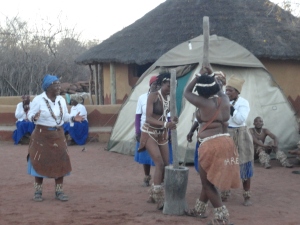
Dinner was interesting. They didn’t enforce the “men first” rule this time around. I loaded up on greens, but they tasted like they had been cooked in black tea–weird. I wolfed them down anyway because vegetables are pretty scarce in my standard Batswana diet. All the greens I’ve had here have been tasty; I just don’t get enough of them. For lunches and dinners, I’ve basically eaten the same thing for each one: half a plate of carbs (white rice, white pasta, or pap), a piece of meat or two (usually chicken or beef), sometimes a smidgen of vegetables, and some gravy. Trying new cuisine is always an adventure, but I do miss my beans and veggies. The diet here is heavy on the bread, white rice, gravy, meat, sugar, and salt. Although, as I’ve recently learned, just about all the porridges are made from whole grains: sorghum and millet. Back home I’m vegetarian, but here it was incredibly difficult to do it at all, let alone be healthy at the same time, and I gave up in the first week.
We sampled a traditional beer called bojalwa jaw setswana,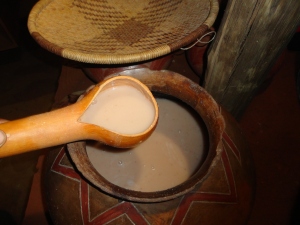 which is made from fermented sorghum. It was a little watery (maybe because they didn’t want to give the strong stuff to young tourists) and tasted yeasty. It was definitely a flavor that took me several sips to adjust to. I can’t say I was a huge fan, but I’m glad I tried it. It also gave me a gentle buzz.
which is made from fermented sorghum. It was a little watery (maybe because they didn’t want to give the strong stuff to young tourists) and tasted yeasty. It was definitely a flavor that took me several sips to adjust to. I can’t say I was a huge fan, but I’m glad I tried it. It also gave me a gentle buzz.
Out around the bonfire, it was nowhere near as cold as the night we spent in Mokolodi. Here we slept in huts and tents; the huts were surprisingly comfortable. One of the international students outside my program, (his name was Skylar), caught two geckos. I asked if I could hold one. It was gorgeous: white with black markings and little rounded toes. Though the poor little fella was terrified after been handled by multiple people and as soon as I loosened my grip, it twisted around and bit me hard on the thumb. I’ve been bitten by a number of lizards before; I have relatives in the Caribbean and Arizona, and when I visited as a kid, my sister and I would play outside and catch them. Bites were never a problem, they never even hurt, but this gecko had teeth or something, because it dug into my finger with something sharp and wouldn’t let go until I put it down in the sand. It left a bite mark ring and I was bleeding pretty badly for such as small bite, but as little Neosporin and a Band-aid later and I was all patched up.
 Before we lined up to wash our hands and get breakfast, one the woman instructed us that it was part of their culture that the men were expected to eat first. This was an experience unique to the villages and rural culture, since while I did notice more men than women cutting lines in Gabs (line-cutting is not uncommon), there was no set rule. As a traveling westerner, I definitely want to respect other cultures and I try to be aware of my own presumptions, but this still rubbed me the wrong way. The “men first” rule when it comes to food is problematic in my eyes: a remnant from old patriarchal practices. In a number of traditionally patriarchal cultures, including those in Europe, historically, there have been issues of women becoming severely malnourished because the men were valued more and were entitled to the best food first. When there wasn’t enough, the women were expected to settle for less or go without. For us, it wasn’t a big deal because obviously Bahurutshe Cultural lodge would provide more than enough food for its tourists.
Before we lined up to wash our hands and get breakfast, one the woman instructed us that it was part of their culture that the men were expected to eat first. This was an experience unique to the villages and rural culture, since while I did notice more men than women cutting lines in Gabs (line-cutting is not uncommon), there was no set rule. As a traveling westerner, I definitely want to respect other cultures and I try to be aware of my own presumptions, but this still rubbed me the wrong way. The “men first” rule when it comes to food is problematic in my eyes: a remnant from old patriarchal practices. In a number of traditionally patriarchal cultures, including those in Europe, historically, there have been issues of women becoming severely malnourished because the men were valued more and were entitled to the best food first. When there wasn’t enough, the women were expected to settle for less or go without. For us, it wasn’t a big deal because obviously Bahurutshe Cultural lodge would provide more than enough food for its tourists.After a breakfast of eggs, beans, ground beef with vegetables, fat cakes, tea, and super-sweet orange juice, we took the bus further out into the bush and “hiked” (more like walked) several kilometers to a gorge.
 Our tour guide told us we couldn’t take photographs unless someone was in them because the gorge was sacred land. I didn’t understand why they allowed photos at all then if the land was sacred, but I assumed it was some sort of odd compromise. We climbed up one part of the gorge that I think is a full-on waterfall during the rainy season. The rocks were a bit slippery, but nothing we couldn’t handle. Our tour guide was pretty nervous about us all climbing safely, though.
Our tour guide told us we couldn’t take photographs unless someone was in them because the gorge was sacred land. I didn’t understand why they allowed photos at all then if the land was sacred, but I assumed it was some sort of odd compromise. We climbed up one part of the gorge that I think is a full-on waterfall during the rainy season. The rocks were a bit slippery, but nothing we couldn’t handle. Our tour guide was pretty nervous about us all climbing safely, though. The short trek was followed by a bush braai and then a cultural performance around the fire back at the Bahurutshe lodge. Everyone has a tribe and totem in Botswana. As one the women was telling us: “When you say ‘crocodile,’ we know where you come from.” Their totem is the baboon. I had mixed feelings about the performance. While I thought it was awesome and entertaining, I wondered if I should have been seeing it at all. It felt like…touristic voyeurism. How often did they perform these dances? Did they still perform them for themselves or was it primarily (or only) for tourists? How did the dancers feel about it? How did they feel about us taking photos? Was it just a job to them? At one point, I noticed one the dancers open her buffalo-skin pouch to check her phone, which was so refreshing. It was something small that broke the ‘traditional’ spell.
The short trek was followed by a bush braai and then a cultural performance around the fire back at the Bahurutshe lodge. Everyone has a tribe and totem in Botswana. As one the women was telling us: “When you say ‘crocodile,’ we know where you come from.” Their totem is the baboon. I had mixed feelings about the performance. While I thought it was awesome and entertaining, I wondered if I should have been seeing it at all. It felt like…touristic voyeurism. How often did they perform these dances? Did they still perform them for themselves or was it primarily (or only) for tourists? How did the dancers feel about it? How did they feel about us taking photos? Was it just a job to them? At one point, I noticed one the dancers open her buffalo-skin pouch to check her phone, which was so refreshing. It was something small that broke the ‘traditional’ spell.
Despite my qualms, many of the dancers looked like they were having a good time and they occasionally laughed amongst themselves and chatted in Setswana. The primary male dancers were absorbed into the performance, going all out with gestures and facial expressions. One of the best performances was a courting dance. As they danced, two older women went around the fire with buckets, throwing water on the sand where the performers stepped. I was excited, because the footwork used in most of the dances was the same as I had learned the previous week in the traditional dance club at the University of Botswana. It was great seeing what the dances were supposed to look like when the dancers were well-practiced, coordinated, and dressed in the traditional garb, which was largely made from animal skins.
After the dances, the older women demonstrated traditional chores/work allocated to girls such as pounding sorghum and grinding it on a rock. The woman who had greeted us earlier that day did all the speaking, (it was clear that she was in charge), and even brought her granddaughter up for some good-natured public embarrassment. Her granddaughter was very modern and was wearing jeans, a T-shirt, flats, and some jewelry. She wasn’t as familiar with the chores as the older women and they laughed benignly at her as her grandmother pretended to scold her. Then the woman invited girls from the audience to come up and try while she sent the few boys to a table to play chess!

Dinner was interesting. They didn’t enforce the “men first” rule this time around. I loaded up on greens, but they tasted like they had been cooked in black tea–weird. I wolfed them down anyway because vegetables are pretty scarce in my standard Batswana diet. All the greens I’ve had here have been tasty; I just don’t get enough of them. For lunches and dinners, I’ve basically eaten the same thing for each one: half a plate of carbs (white rice, white pasta, or pap), a piece of meat or two (usually chicken or beef), sometimes a smidgen of vegetables, and some gravy. Trying new cuisine is always an adventure, but I do miss my beans and veggies. The diet here is heavy on the bread, white rice, gravy, meat, sugar, and salt. Although, as I’ve recently learned, just about all the porridges are made from whole grains: sorghum and millet. Back home I’m vegetarian, but here it was incredibly difficult to do it at all, let alone be healthy at the same time, and I gave up in the first week.
We sampled a traditional beer called bojalwa jaw setswana,
 which is made from fermented sorghum. It was a little watery (maybe because they didn’t want to give the strong stuff to young tourists) and tasted yeasty. It was definitely a flavor that took me several sips to adjust to. I can’t say I was a huge fan, but I’m glad I tried it. It also gave me a gentle buzz.
which is made from fermented sorghum. It was a little watery (maybe because they didn’t want to give the strong stuff to young tourists) and tasted yeasty. It was definitely a flavor that took me several sips to adjust to. I can’t say I was a huge fan, but I’m glad I tried it. It also gave me a gentle buzz.Out around the bonfire, it was nowhere near as cold as the night we spent in Mokolodi. Here we slept in huts and tents; the huts were surprisingly comfortable. One of the international students outside my program, (his name was Skylar), caught two geckos. I asked if I could hold one. It was gorgeous: white with black markings and little rounded toes. Though the poor little fella was terrified after been handled by multiple people and as soon as I loosened my grip, it twisted around and bit me hard on the thumb. I’ve been bitten by a number of lizards before; I have relatives in the Caribbean and Arizona, and when I visited as a kid, my sister and I would play outside and catch them. Bites were never a problem, they never even hurt, but this gecko had teeth or something, because it dug into my finger with something sharp and wouldn’t let go until I put it down in the sand. It left a bite mark ring and I was bleeding pretty badly for such as small bite, but as little Neosporin and a Band-aid later and I was all patched up.